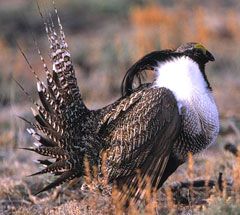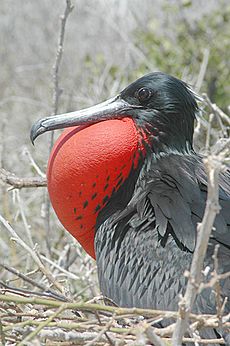Gular skin facts for kids
Gular skin is a special area of skin found on the throat of some animals. In birds, it's a patch of skin without feathers. This skin connects the lower part of a bird's beak (called the mandible) to its neck. You might also hear it called a gular sac, throat sac, or vocal sac, especially in other animals.
Contents
Gular Skin in Birds
Gular skin can be very easy to see in certain birds. For example, birds like pelicans and cormorants often have very noticeable gular skin. In many of these species, the gular skin forms a loose flap. This flap is often called a gular pouch. Birds use this pouch to hold fish or other food they catch while hunting.
Cormorants and Their Colors
In birds like cormorants, the gular skin often has bright colors. These colors stand out against the bird's mostly black or black-and-white feathers. Scientists believe these colors help birds communicate with each other. The colors become even brighter when the birds are ready to find a mate and breed. This helps them show off to other birds.
Frigatebirds and Their Amazing Sacs
Frigatebirds use their gular skin in a very dramatic way. Their gular skin forms a large gular sac or throat sac. When a male frigatebird wants to attract a female, he fills this sac with air. It takes about 20 minutes for the sac to inflate. It turns into a huge, bright red balloon! This amazing display helps the male frigatebird find a partner.
How Gular Pouches Evolved
Cormorants are more closely related to birds like gannets and anhingas. These birds do not have a large gular pouch. However, cormorants are not as closely related to frigatebirds or pelicans, which do have prominent gular pouches. This suggests that the gular pouch either appeared very early in bird history and was lost in some groups, or it developed separately in different bird groups over time. This is known as parallel evolution.
Gular Skin in Other Animals
Besides birds, other animals also have similar throat structures.
Mammals with Gular Skin
The orangutan is a type of great ape. Male orangutans are the only great apes known to have a gular sac. The walrus also has a throat sac. Some types of gibbons, like the siamang, also have a throat sac.
Amphibians and Their Vocal Sacs
Many amphibians, such as frogs, have a vocal sac. They inflate this sac to make loud sounds. These sounds help them communicate with each other. They might use their voices to scare away rivals or to find and attract a mate. The gular sac helps make their voices louder and seem closer.
Lizards and Dinosaurs
Some types of lizards also have a gular fold on their throats. This fold often has special gular scales. Even some ancient animals had gular pouches! The theropod dinosaur Pelecanimimus lived about 130 million years ago. It had a gular pouch that was similar to a pelican's. This is why it was named "Pelecanimimus," which means "pelican mimic."
Images for kids
-
A male Greater sage-grouse with its gular sacs inflated.
See also
 In Spanish: Saco gular para niños
In Spanish: Saco gular para niños




